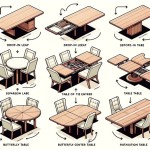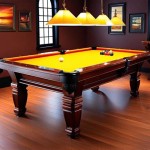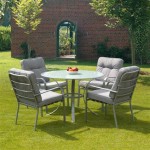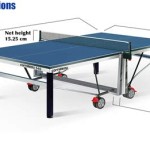66 Inch Round Table: Seating Capacity Considerations
Determining the appropriate seating capacity for a 66-inch round table is crucial for ensuring comfortable and functional dining or meeting arrangements. This capacity is influenced by several factors, including the intended use of the table, the size and style of the chairs, and the desired level of personal space for each individual. Accurately assessing these variables allows for the optimization of space and the creation of a pleasant and practical environment.
A round table, by its very nature, encourages conversation and facilitates interaction among those seated around it. The absence of corners promotes a sense of equality and allows for easy visibility and communication between all participants. These inherent advantages make round tables a popular choice for both formal and informal settings, from dining rooms and conference halls to restaurants and banquet facilities.
However, maximizing the benefits of a round table requires careful consideration of its dimensions and the number of people it can comfortably accommodate. Overcrowding can lead to discomfort and hinder interaction, while underutilization can make a space feel empty and impersonal.
Estimating Seating Capacity Based on Spacing
The most significant factor in determining the seating capacity of a 66-inch round table is the amount of space allotted to each individual. A general rule of thumb is to provide approximately 24 inches of linear space per person. This allows for adequate elbow room while eating or working and prevents individuals from feeling cramped or restricted. This measurement represents the arc length available along the table's edge for each seat.
To calculate the circumference of a 66-inch round table, we use the formula: Circumference = πd, where d is the diameter and π (pi) is approximately 3.14159. Therefore, the circumference of the table is approximately 3.14159 * 66 inches, which equals approximately 207.35 inches. To determine the number of people that can be seated comfortably, the total circumference is divided by the preferred spacing per person.
Based on the general rule of 24 inches per person, 207.35 inches / 24 inches/person ≈ 8.64 people. This result suggests that a 66-inch round table can comfortably accommodate 8 people. It is common practice to round down to the nearest whole number to ensure sufficient comfort. Thus, based strictly on spacing, a 66-inch round table can realistically seat 8 individuals.
However, different scenarios may necessitate deviations from this basic calculation. For example, if the table is used for a more formal dining experience with multiple courses and larger place settings, allocating slightly more space per person might be preferable.
Influence of Chair Size and Style
The style and dimensions of the chairs significantly influence the comfortable seating capacity of a 66-inch round table. Bulky chairs with wide arms require more space than sleeker, armless designs. Consider the footprint of the chair when occupied. A chair that extends further away from the table necessitates more space between neighboring seats.
For instance, if using chairs with wide arms that require 26 inches of linear space each, the calculated seating capacity would change. Dividing the circumference (207.35 inches) by 26 inches/person results in approximately 7.98 people. In this case, the practical seating capacity would be reduced to 7 people to prevent overcrowding and ensure optimal comfort.
Furthermore, the ability of the chairs to be easily moved or adjusted also affects the overall functionality of the seating arrangement. Chairs that are too heavy or difficult to maneuver can hinder movement around the table and make it challenging for individuals to enter and exit their seats. The shape and angle of the chair back can also play a role, particularly if the chairs are positioned closely together.
It is recommended to select chairs that complement the style and size of the table while prioritizing comfort and ease of use. Experimentation with different chair styles is helpful in determining the optimal configuration for a specific space and intended purpose.
Considering the Intended Use of the Table
The intended use of the 66-inch round table plays a crucial role in determining the appropriate seating capacity. A dining table meant for regular meals may require a different configuration than a conference table used for meetings or a display table in a retail environment. The presence of serving dishes, centerpieces, or work materials must also be factored into the equation. A sparsely decorated table can allow for higher seating capacity than one with large or bulky object covering the surface.
If the table is intended for dining, the size of the place settings and the number of courses served should be considered. Formal dinners with multiple plates, glasses, and utensils necessitate more space per person than casual meals with minimal place settings. The presence of serving dishes on the table also reduces the available space for individual diners.
For conference tables, the need for laptops, notebooks, and other work materials should be considered. Participants will require sufficient space to work comfortably without encroaching on each other's space. Power outlets and data ports should be easily accessible to all participants, which may influence the placement of chairs and the overall seating arrangement. In cases where the table is being used for computer work, increasing the calculated seat space by 1-2 inches per person can significantly improve comfort.
Display tables, often found in retail stores or at events, may not be intended for seating at all. However, the space around the table should be sufficient to allow customers or attendees to comfortably view the displayed items without feeling crowded or restricted. In these cases, the focus shifts from seating capacity to accessibility and visual appeal.
In summary, assessing seating for a 66-inch round table requires more than just a simple calculation based on circumference. The chair style, the intended use of the table, and the degree of personal space desired each contribute to a final, practical number of people that can be comfortably accommodated.
Therefore, while the mathematical estimate provides a good starting point, careful consideration of these secondary factors facilitates the creation of a welcoming and functional space suited to a specific setting and need.

Professional Table Seating Guide The Chiavari Chair Company Is Now Chivari

66 Round Table Stuart Event Als

Buy 66 Round Wood Folding Table Globaleventsupply Com

Round Table 66 Inch Als Monterey Ca Where To In Peninsula

Signature Party Als Round Table 66

66 Inch Round Tables Just 4 Fun Party Als Santa Barbara

66 Round Table The Party Als Resource Company

66 Inch Round Tables Just 4 Fun Party Als Santa Barbara

Professional Table Seating Guide The Chiavari Chair Company Is Now Chivari

Maison Dining Table 66 Round Nüage Designs








